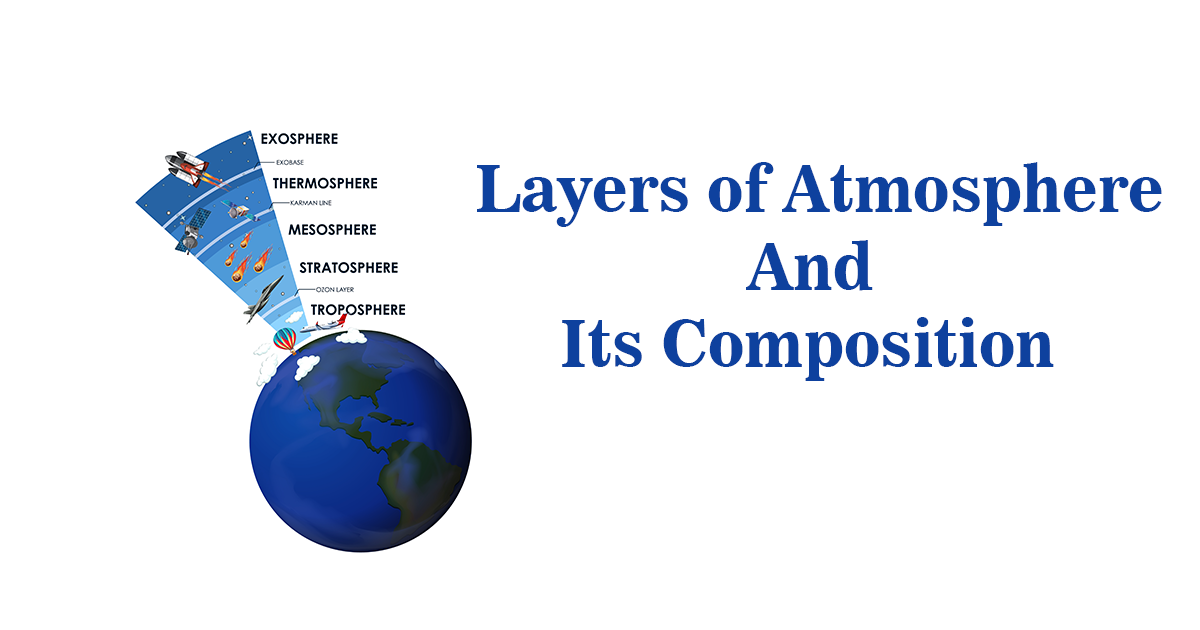
About Atmosphere
How would you define the atmosphere? A thick layer of gaseous particles that surrounds the Earth is known as an atmosphere. Due to the Earth’s gravitational pull, these gaseous particles are kept close to the surface. Although there are many elements in the atmosphere, nitrogen, oxygen, and argon gas make up the majority of it. The atmosphere’s presence on Earth is necessary for the existence of the diverse creatures’ life cycles. This article provides a thorough explanation of the atmosphere’s structure, including its layers.
Details of Composition of Atmosphere
It may surprise you to learn that our atmosphere is made up of a variety of gaseous particles. The preservation of life on Earth depends on these gases. Aerosols, which are both solid and liquid particles, are another component of the atmosphere. These elements of the atmosphere contribute to the preservation of the ideal pressure and temperature for the existence of life. It filters off ultraviolet (UV) radiation, which is among the most dangerous solar rays.
| Constituents of Atmosphere | Percentage |
| Nitrogen Gas | 78.09% |
| Oxygen Gas | 20.95% |
| Argon Gas | 0.93% |
| Other Miscellaneous Gas | 0.03% |
Layers of Atmosphere
What are the many atmospheric layers? Based on pressure and height above sea level, the atmosphere of Earth is divided into five layers. As we ascend, the atmospheric pressure drops with height. At higher altitudes and below sea level, respectively, the air pressure is minimal. Higher temperatures cause lower pressure, whereas gloomy skies and wet weather help to counteract lower atmospheric pressure. On the other hand, the clear and sunny skies help lower the higher pressure. Warm air always rises and forms a low-pressure area, whereas cold, heavy air descends and forms a high-pressure area.
| Different Layers of Atmosphere | Height | Temperature with Height | Upper Limit |
| Troposphere | 0- 18 Km | Decreases | Tropopause |
| Stratosphere | 18- 50 Km | Increases | Stratopause |
| Mesosphere | 50- 90 Km | Decreases | Mesopause |
| Thermosphere/ Ionosphere | 80- 640 Km | Increases | Thermopause |
| Exosphere | Up to 10,000 Km | Increases | Exopause |
Troposphere
The lowest part of the atmosphere on Earth is called the troposphere. It reaches 8 km in the poles and 18 km at the equator from sea level. This layer of the atmosphere contains the entire atmosphere. This layer is where storms, rainfall, and other weather-related events take place. Here, you’ll mostly find a lot of dust particles, water vapours, and other unclean gaseous particles. This is where the air that we breathe during breathing exists.
This layer of the atmosphere keeps the Earth warm because it absorbs the majority of the heat emitted by the planet’s surface. The temperature in this layer decreases with height at a rate of 6.5 degrees per 1000 metres, or what is known as a typical lapse rate. The tropopause, which is 1.5 Km thick, is the top boundary of the troposphere. The layer dividing the troposphere from the stratosphere above is known as the tropopause.
Stratosphere
Above the troposphere is the stratosphere. It rises from the bottom to a height of nearly 50 km. Cirrus clouds and modest wind circulation are both prevalent in the lower stratosphere. It facilitates favorable airspace conditions for flight. As a result, airplanes, jets, and airplanes travel over the lower stratosphere.
It also has an ozone layer, which serves as protection by absorbing UV sun rays. It contributes to lowering Earth’s temperature in this way. Because ozone molecules are present in this layer, the temperature rises with height. Because it could raise Earth’s temperature and contribute to global warming, ozone depletion is extremely worrisome for the planet. The stratopause is the term for the stratosphere’s uppermost layer.
Mesosphere
The third layer of the atmosphere over the stratosphere is known as the mesosphere. It rises from the bottom to a height of 50–90 km. This layer is the coldest in the atmosphere since its temperature decreases with height. At a height of 80-90 km, the temperature can drop as low as -80 degrees Celsius. Celestial bodies like meteorites that enter this layer of the atmosphere from space burn up as they enter. Mesopause refers to the mesosphere’s uppermost layer.
Thermosphere/ Ionosphere
Above the mesosphere is the thermosphere. It rises from the earth to a height of 80–640 km. Due to the sun’s UV and X-ray radiation, the temperature in this layer rises with height. In the upper thermosphere, the temperature can rise to its greatest point of roughly 2000 degrees Celsius. This layer is where weather phenomena like the aurora, northern lights, and southern lights occur.
Because there are electrically charged particles present in this layer of the atmosphere, it is also known as the ionosphere. As it destroys meteorites and other celestial bodies, it also shields Earth from their impact. The radio waves that are broadcast from the Earth are reflected back to it by this layer. It should be emphasized that only in this layer do satellites that have been launched from Earth orbit the planet.
Exosphere
The uppermost atmosphere on Earth, located above the ionosphere, is known as the exosphere. It reaches a height of 10,000 km from the ground. In this layer, the air density is lower and the temperature rises to 5568 degrees Celsius. The layer is really close to space. The air density in outer space is lower because of the movement of lighter gaseous hydrogen and helium particles. Although the exosphere does not have a distinct upper layer, we regard the exopause’s hypothetical line to be the boundary between the exosphere and space.




